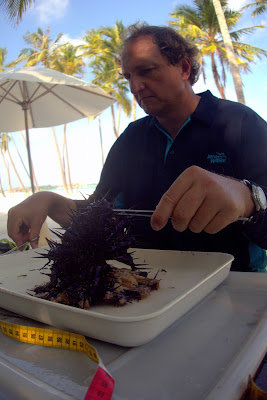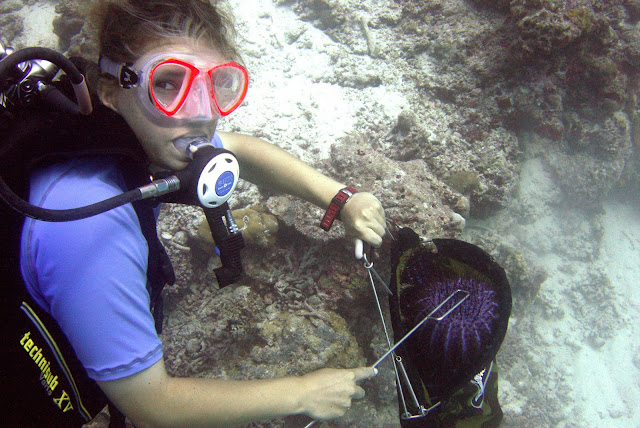We have had a busy week here in the Marine Biology section as we welcomed more international researchers to our little slice of paradise!
 |
| The most beautiful pest in the World? Starfish devour the only piece of living coral left on this reef |
Following the recent Crown of Thorns Starfish (COTS) outbreak on reefs in the Maldives, many reef managers, including ourselves, were concerned for the reef’s health. As such, we have collectively reached out to all corners of the globe for help, so that we might better understand and control this plague. Our call was answered this week by a research team from James Cook University in Australia.
You may remember that with the help of the Living Oceans Foundation in October, Gili Lankanfushi removed 1000 individuals over a 2km reef tract during a 4 day period. With each starfish capable of eating a dinner plate sized amount of coral per day, you can see why these creatures are recognised as a pest. When the population density is high enough, they can decimate entire reefs in a matter of weeks! Removing them from the ecosystem during outbreaks is the only way we can hope to control numbers and save our reef!
 |
| Not a bad office: Prof. Pratchett dissects one specimen to determine fecundity |
Whilst these outbreaks are detrimental for the reef systems, they also provide an opportunity for us to study these infamous creatures, in the hope to understand more about their ecology and biology. Without this knowledge, we cannot hope to develop successful control techniques. At Gili Lankanfushi, we were lucky enough to host one of the World’s leading authorities on COTS ecology; Professor Morgan Pratchett from James Cook University in Townsville, Australia.
The majority of Morgan’s experience with COTS has been from the Great Barrier Reef, and having never visited the Maldives before, he was keen to jump in the water and study our beautiful purple colourmorph populations. We had just 4 days to remove starfish from the reef and process them for genetic study and to assess their fecundity (their capacity to produce offspring). Over the course of the field trip, we removed 100 starfish and were able to collect samples from them all for further study. Some whole specimens of this understudied North Indian Ocean morph have even gone to various museums to be compared to other starfish in the same family!
 |
| Debs gets involved with the removal effort in an attempt to save our reef! |
Using the data, we hope to understand more about the population dynamics of this particular outbreak, and once armed with more knowledge, we might be able to prepare more effectively for future invasions!
The Marine Biology team are really grateful to the management of Gili Lankanfushi Resort for supporting such important research studies, and we look forward to making more great connections with the international scientific community.